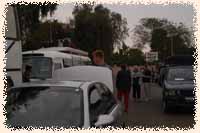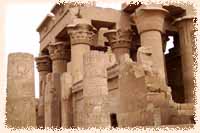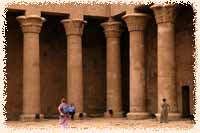










sites/photos
Convoy
Temple of Kom Ombo
Temple of Edfu
history
hotel
notes
temples
architecture
hieroglyphs
driving
tipping
toilets
david roberts
February 12 2003:
Convoy day! We're going to Luxor by road, and official "tourists" have to have a police escort on the road between Aswan and Luxor. Mark is pretty interested in the setup of the convoy -- I can't help notice a lot of armed soldiers, milling around the busses and leaning against the railing on the corniche. There are probably ten or so busses and another dozen cars or vans, clustered in the alley, waiting for the OK.
English Time
 We were up and ready by 7:30 and asked the bell captain
to have our luggage in the lobby at 7:30 so we wouldn't
miss the convoy. At 7:28, he arrived. He checked his
watch, grinned, and said "English time!" before hauling
it out. We've learned not to worry about it. Punctuality is not a virtue here. It's hot, things move slowly. Go with it. After awhile, it's rather relaxing.
We were up and ready by 7:30 and asked the bell captain
to have our luggage in the lobby at 7:30 so we wouldn't
miss the convoy. At 7:28, he arrived. He checked his
watch, grinned, and said "English time!" before hauling
it out. We've learned not to worry about it. Punctuality is not a virtue here. It's hot, things move slowly. Go with it. After awhile, it's rather relaxing.
At 8:30 or so (quite prompt, really) we all set off at ludicrous speed up the narrow road. I wrote a lot about the vagaries of driving when we got back from Scotland -- I was just flabbergasted by the haphazard parking rules in the cities and the narrow, one-lane roads in the country. I will never complain about UK traffic again. Ever. Cairo was downright frightening a few times. In some cases, our driver, Mr. Mohammad, would fold in the mirrors of the Mercedes minivan that we were driving, so that he could squeeze into some particularly tiny place. Oncoming traffic in your lane (passing someone form their direction) heads straight at you -- until the very last moment, when everyone swerves.
Everyone wants to drive in the middle of the road. That is the ONLY explanation for the traffic patterns that we saw. Everyone, given enough room, will drive straddling the dotted line. Keeps you from having to swerve to avoid the cows and water buffalo that leap unannounced into the road. But, there is a drawback. If you get a few cars following along together (like, say, for example, in a convoy), the second car has to move over just a tad to see around the car in front, and the third car a little farther to the left than that...Eventually, you end up with a diagonal trail of cars from the center line to the left shoulder, all jockeying for position to see what is coming up next. They all collapse to the right when a car approaches, then slowly sliiiide back out to the side when it's clear. if you're in the last car, the collapse part of that process can get pretty violent. You careen to the right to slip behind the car ahead as the huge truck loaded with sugar cane or propane bottles wheels by at high speed, only a few feet away.
It's about 45 minutes to Kom Ombo. The town is busy, and we peeled off to the temple as soon as the car stopped. It's the second day of Festival so the streets are hugely crowded but we pushed our way through past the souk and to the temple.
Kom Ombo was ruined and covered in sand only a hundred years ago -- now it stands on a rocky cliff off the Nile. Most of the carvings are defaced, but its a stirring temple and still very colorful. You can't see the temple from below on the road -- only the mud brick walls are visible. But the hypostyle hall is colored just like D. Roberts' paintings.
 Only had an hour here - then back to the car, since we're on the convoy's schedule. One
particularly close call with a bus made me shriek
(just a little) to which George responded, "He's
a professional. Been driving since he was 10" and Mark responded by putting on his seatbelt for
the first time on our trip. Everyone laughed. It's
another two hours to Edfu.
Only had an hour here - then back to the car, since we're on the convoy's schedule. One
particularly close call with a bus made me shriek
(just a little) to which George responded, "He's
a professional. Been driving since he was 10" and Mark responded by putting on his seatbelt for
the first time on our trip. Everyone laughed. It's
another two hours to Edfu.
Toilet Mafia
By the time we reached Edfu, we were ready to get out of the car again. Edfu has a huge number of caleches, horse drawn buggies
mostly for tourists. Aswan has them, too, but the
horses in Edfu are the sorriest lot I've ever seen.
it's really sad. Some of the horses are so skinny and
covered in harness sores. It's even more sad to see
that tourists will still get into those caleches with
sick, near-dead horses. Hire those with healthy horses,
or not at all. maybe by not using those who do not
treat their animals well, we may effect some tiny
change. We didn't ride in the caleches. There is a good essay in the Rough Guide regarding the situation with Horses in Egypt.
There is an even bigger bazaar in Edfu with hundreds of caleches and we got out of the car about two blocks from the temple and walked the gauntlet of stalls and trinket sellers. Edfu is the largest preserved temple in Egypt-- it is enormous and, more surprising still, mostly roofed. The ceiling is blackened by oil lamps and campfires from when people lived in the temple. It is an odd temple, so large as to seem disjointed. There is a huge setup for a sound and light show here, but it is not running yet. Many guards and pillboxes dot the mud brick temple wall.
It is interesting to see just what the temples really looked like. So many are ruined that it is hard to imagine how they were, whole and new, and what kind of impression we might have gotten had we seen them while they were still "alive". Our guides have pointed out that temples would have been plastered white, with the reliefs painted in bright colors and gold leaf. It's a far cry from the sandstone we see now. The carvings are beautiful unadorned, I can only imagine them fully colored. THen again, maybe not -- history tells us that the white marble statues of Rome were once gaily -- or gaudily -- painted. I'm not sure if it is an improvement of not.
The convoy people change places in Edfu -- the police from Luxor just loop from Luxor to Edfu and those from Aswan turn back. We had to wait for the other guys to show up. The convoy headed off again for the 120 km to Luxor.
 We stopped to go to bathroom and it was the only negative experience we had in Egypt. Usually, there is a young girl or boy in the bathroom who will hand you a few squares of toilet paper and is ostensibly supposed to clean up the bathroom. You tip them a few coins or a pound and go on your way. But here, a large, middle-aged man planted himself in front of the door to the men's bathroom and demanded LE1 to go inside. Now, I have no problem leaving small baksheesh for the toilet-minder, but to stand there, blocking the door with his hand held out was just a bit much. I'm sure it worked pretty well, with the stream of tourists unsure what to do and slightly embarrassed by the whole transaction. Mark later said he wished he had the cojones to just pee on the guys shoe.
We stopped to go to bathroom and it was the only negative experience we had in Egypt. Usually, there is a young girl or boy in the bathroom who will hand you a few squares of toilet paper and is ostensibly supposed to clean up the bathroom. You tip them a few coins or a pound and go on your way. But here, a large, middle-aged man planted himself in front of the door to the men's bathroom and demanded LE1 to go inside. Now, I have no problem leaving small baksheesh for the toilet-minder, but to stand there, blocking the door with his hand held out was just a bit much. I'm sure it worked pretty well, with the stream of tourists unsure what to do and slightly embarrassed by the whole transaction. Mark later said he wished he had the cojones to just pee on the guys shoe.
Luxor
Luxor is a small city, too, but very welcoming and
the Old Winter Palace is very nice. We had the option
of a room with a double bed or one with singles. The
one with singles was larger, and a corner room with
a huge balcony (20 x 20) with deck chairs. Oh, it
sucks to be us. The bathroom is huge, too, and modernized
completely. Tourists and groups cannot tour the hotel
and only guests can come in to use the gardens. We're
special.
We walked around a bit, went to the bank, investigated the doves in the garden and the antiques in the lounge. Ate a late dinner at the hotel and sat on the verandah for awhile. Very, very nice.
There was a huge sandstorm at night, so we couldn't leave the windows open. We bought BOREOS at a kiosk on the corniche along with a few bottles of water and a diet coke. They look like OREOS, but there the similarity ends! There are a lot of "knock off" foods in Egypt -- it's kind of fun to browse the shelves and see what things are supposed to be. Usually the logos and colors are very similar to European or American products.